The Georgia coast has long captured the attention of scientists interested in its biological and geological systems and how these two realms overlap. For example, starting in the 1950s, ecologists – people who study the connections between living and non-living things in ecosystems – began investigating the exchange of energy and matter between the plants and animals of the Georgia barrier islands. In particular, they were interested in the Georgia salt marshes, most of which are between the mainland and the upland portions of the barrier islands. Why study salt marshes in Georgia, and not somewhere else? And how do the traces of plants and animals in these marshes, such as root disturbances, scrapings, burrows, and feces, actually play a major role in the functioning of these ecosystems?
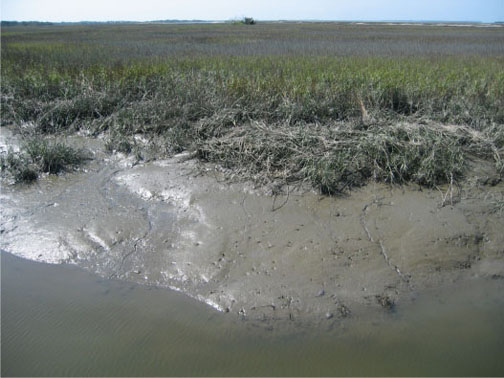 The muddy bank of a tidal creek in a typical salt marsh on St. Catherines Island, Georgia. See the traces? No? It’s a trick question: it’s made of nothing but traces. Photograph by Anthony Martin.
The muddy bank of a tidal creek in a typical salt marsh on St. Catherines Island, Georgia. See the traces? No? It’s a trick question: it’s made of nothing but traces. Photograph by Anthony Martin.
Georgia salt marshes are flat, extensive coastal “prairies” dominated by a tall, marine-adapted grass, smooth cordgrass (Spartina alterniflora) in their lowermost parts. These ecosystems turned out to be fantastic places for scientists to study basic principles of ecology, and are among the most productive of all ecosystems, besting or equaling tropical rain forests in this respect. Georgia salt marshes also represent about one-third of all salt marshes in the eastern U.S. by area. How did this happen?
Such an unusual concentration of salt marshes along the relatively small Georgia coastline is a result of several factors. One is its semi-tropical climate, only rarely dipping below freezing, which allows marsh plants and animals to thrive and actively participate in their ecosystems nearly year-round. Another is the high tidal range of the Georgia coast of about 2.5-3 meters (8-10 feet), which causes enormous amounts of organic material – living and nonliving – to get cycled in and out of the marshes by this moving water.
A third reason, and perhaps the most important, is what people did not do to the marshes, which was to develop them in ways that would have completely altered their original ecological characters. (Take a look at the barrier islands of New Jersey as examples of what could have happened in Georgia.) Salt marshes that were not drained, filled in, paved over, or otherwise irreparably altered could be studied for what they were, not what we supposed.
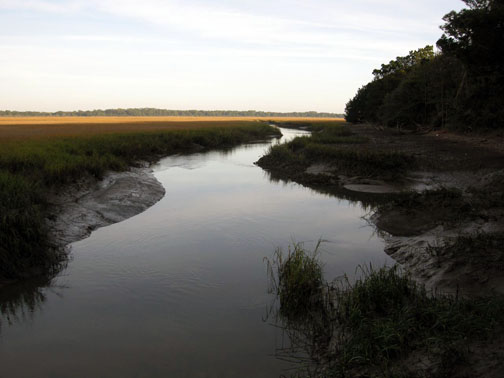 Salt marsh and tidal creek adjacent to a maritime forest on Cumberland Island. Fortunately, this is a typical sight on the Georgia barrier islands, which gladdens ecologists and lots of other people who prefer to see their landscapes unpaved.
Salt marsh and tidal creek adjacent to a maritime forest on Cumberland Island. Fortunately, this is a typical sight on the Georgia barrier islands, which gladdens ecologists and lots of other people who prefer to see their landscapes unpaved.
The scientists interested in the Georgia salt marshes, among them Eugene (“Gene”) Odum, Mildred Teal, and John Teal, were astonished by the amount of organic matter produced in these marshes, especially in their lower parts, which were appropriately called low marsh. Amazingly, much of this flux is controlled by tides and just five species of organisms you can easily see any given day in these marshes:
- Smooth cordgrass (Spartina alterniflora)
- Ribbed mussels (Geukensia demissa)
- Eastern oysters (Crassostrea virginica)
- Marsh periwinkles (Littoraria irrorata)
- Mud fiddler crabs (Uca pugnax)
Just to oversimplify matters, but to assure that you get the big picture, the flow of matter and energy goes like this. Smooth cordgrass is the primary producer of organic material in the salt marshes, converting sunlight into food for it and, as it turns out, lots of other organisms. This is relatively easy for these plants because they are powered by intense Georgia sunlight much of the year. Smooth cordgrass also has extensive and complicated root systems, which help to hold most of the marsh muds in place when marshes are flushed by the tides. These roots locally change the chemistry of the surrounding mud and otherwise leave visible traces of their deeply penetrating networks, which are noticeable long after the plants had died and decayed.
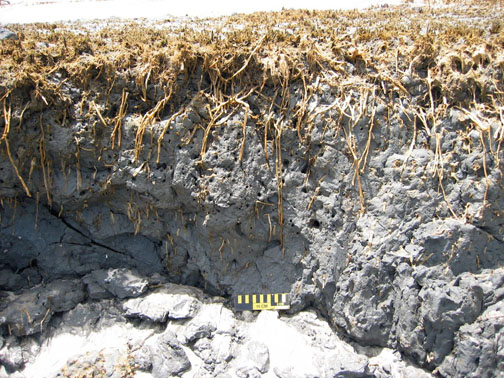 Cross-section of a relict salt marsh preserved on Sapelo Island, Georgia, buried for about 500 years but just now being exhumed by shoreline erosion. See how deeply those roots of smooth cordgrass (Spartina alterniflora) penetrate the mud and still hold it in place? Modern ones do the same thing. Scale = 15 cm (6 in).
Cross-section of a relict salt marsh preserved on Sapelo Island, Georgia, buried for about 500 years but just now being exhumed by shoreline erosion. See how deeply those roots of smooth cordgrass (Spartina alterniflora) penetrate the mud and still hold it in place? Modern ones do the same thing. Scale = 15 cm (6 in).
What produces the mud in a marsh? Mostly the ribbed mussels, oysters, and similar suspension-feeding animals, which: suck in water made cloudy by suspended clays; consume any useful organics that might be in that water; and excrete massive amounts of mud-filled feces, packaged with mucous as sand-sized particles. The oysters, along with cordgrass roots, stabilize the banks of tidal creeks, keeping these from washing away with each ebb tide.
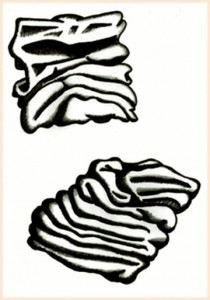 If you’ve ever wondered what ribbed mussel (Geukensia demissa) feces look like, you’re in luck. Each one is only about 1 millimeter (0.04 inches) across, which makes them behave more like sand instead of much tinier clay particles. Also think of them as little packets of mud shrink-wrapped by mucous. Illustration by Anthony Martin, based on a figure by Smith and Frey (1985).
If you’ve ever wondered what ribbed mussel (Geukensia demissa) feces look like, you’re in luck. Each one is only about 1 millimeter (0.04 inches) across, which makes them behave more like sand instead of much tinier clay particles. Also think of them as little packets of mud shrink-wrapped by mucous. Illustration by Anthony Martin, based on a figure by Smith and Frey (1985).
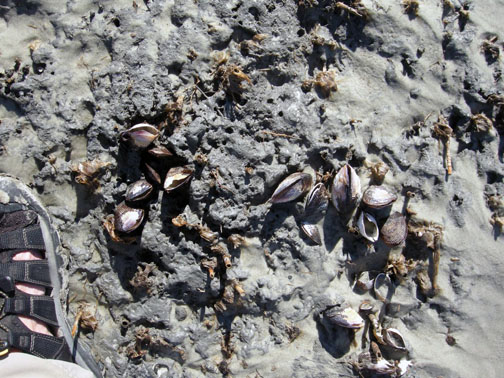 A view of what used to be a marsh surface – the relict marsh on Sapelo Island, that is – with stubs of long-dead smooth cordgrass accompanied by equally long-dead clusters of ribbed mussels (Geukensia demissa). Back in the day (about 500 years ago), these mussels were happily pumping out mud-filled feces, and their modern descendants are still doing the same thing. Sandal (left) is size 8½ (mens). Photograph by Anthony Martin.
A view of what used to be a marsh surface – the relict marsh on Sapelo Island, that is – with stubs of long-dead smooth cordgrass accompanied by equally long-dead clusters of ribbed mussels (Geukensia demissa). Back in the day (about 500 years ago), these mussels were happily pumping out mud-filled feces, and their modern descendants are still doing the same thing. Sandal (left) is size 8½ (mens). Photograph by Anthony Martin.
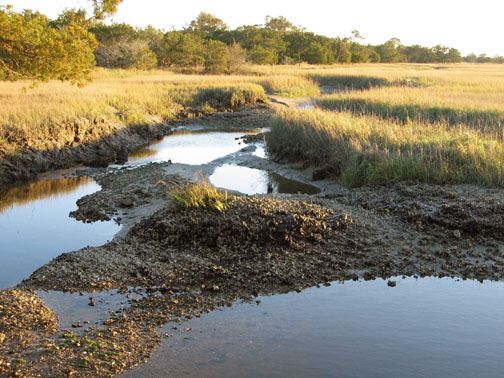 Prominent clumps of eastern oysters (Crassostrea virginica), exposed at low tide in the middle of a tidal creek on Sapelo Island. These not only help to produce mud, but keep it in place, while also slowing down flow and helping to deposit mud. Photograph by Anthony Martin.
Prominent clumps of eastern oysters (Crassostrea virginica), exposed at low tide in the middle of a tidal creek on Sapelo Island. These not only help to produce mud, but keep it in place, while also slowing down flow and helping to deposit mud. Photograph by Anthony Martin.
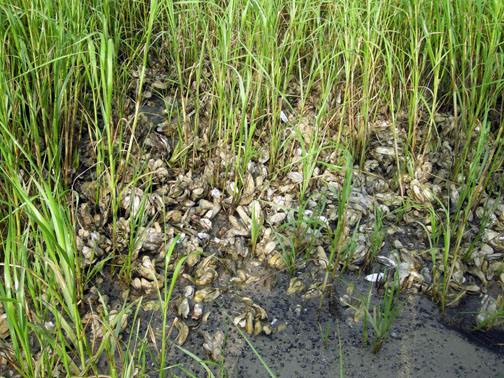 A close-up look at more oysters surrounded by smooth cordgrass, with both working together to bind and accumulate mud on Sapelo Island. Now that’s ecological teamwork! Photograph by Anthony Martin.
A close-up look at more oysters surrounded by smooth cordgrass, with both working together to bind and accumulate mud on Sapelo Island. Now that’s ecological teamwork! Photograph by Anthony Martin.
Both the cordgrass and oysters also baffle and otherwise slow down the water flow, causing mud – fecal or otherwise – to get deposited. In short, a Georgia salt marsh with its thick deposits of beautifully dark, rich, gooey mud, much of which consists of the traces of mussels and oysters, would cease to exist without these bivalves and smooth cordgrass, and would become more like an open lagoon.
Meanwhile, marsh periwinkles are constantly moving up and down the stalks and leaves of the smooth cordgrass, grazing on algae growing on the cordgrass. This activity causes visible damage to the plants, tearing them into small bits and pieces that fall onto the marsh surface.
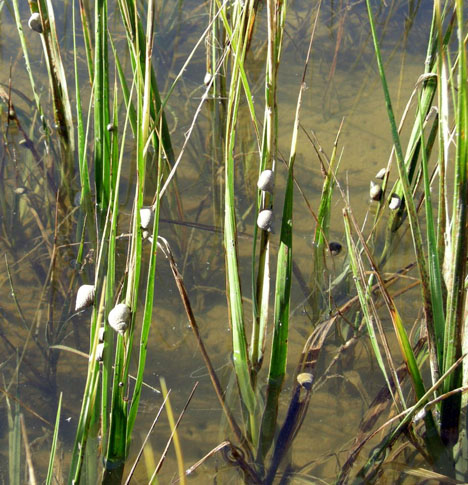 Marsh periwinkles (Littoraria irrorata) doing what they do best, which is graze on the stalks and leaves of smooth cordgrass, leaving many traces from damaging these plants while also contributing plant debris to the marsh surface. Photograph by Anthony Martin, taken on Sapelo Island.
Marsh periwinkles (Littoraria irrorata) doing what they do best, which is graze on the stalks and leaves of smooth cordgrass, leaving many traces from damaging these plants while also contributing plant debris to the marsh surface. Photograph by Anthony Martin, taken on Sapelo Island.
Fungi and bacteria further break down this “gentle rain from heaven” of cordgrass debris once it reaches the marsh surface. Here, mud fiddler crabs consume this stuff, along with any algae that might be growing on marsh surfaces. Their scrape marks and discarded balls of processed sediment are everywhere to be seen on the marsh surface and add to the sediment load of a marsh. Furthermore, as we may have learned in grade school, all animals poop, so in this way these fiddler crabs and other species of crabs living in the salt marshes donate even more enriched organic material. They also dig millions of burrows, some adorned by prominently pelleted turrets, churning the uppermost part of the marsh mud like earthworms would do to a soil in a forest or field.
 Mud fiddler crabs (Uca pugnax) and their many traces on a salt marsh surface, including feeding pellets, scrape marks, and burrows. Photo by Anthony Martin, taken on Sapelo Island.
Mud fiddler crabs (Uca pugnax) and their many traces on a salt marsh surface, including feeding pellets, scrape marks, and burrows. Photo by Anthony Martin, taken on Sapelo Island.
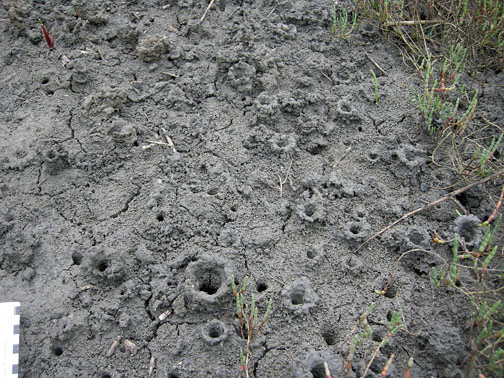 Mud-fiddler crab burrows exposed at low tide in a marsh, many with pellet-lined turrets. Why do they make these structures? Good question, which I’ll try to answer in the future. Photo by Anthony Martin, taken on Sapelo Island.
Mud-fiddler crab burrows exposed at low tide in a marsh, many with pellet-lined turrets. Why do they make these structures? Good question, which I’ll try to answer in the future. Photo by Anthony Martin, taken on Sapelo Island.
Hence you cannot go to a Georgia salt marsh and say, “I can’t see any traces,” unless you are closing your eyes or are otherwise sight deprived. The entire salt marsh is composed of traces, and these traces, which are the products of plant and animal behavior, actually control the ecology of the salt marshes. Thus I often refer to Georgia salt marshes as examples of “ichnological landscapes,” places that are the sum of all traces. This concept then better prepares us for viewing these and other Georgia coastal environments as places where geologists can begin to understand how organisms can leave their marks – both big and small – in the geologic record.
Further Reading:
Craige, B.J. 2001. Eugene Odum: Ecosystem Ecologist and Environmentalist. University of Georgia Press, Athens, Georgia: 226 p.
Odum, E.P. 1968. Energy flow in ecosystems; a historical review. American Zoologist, 8: 11-18.
Odum, E.P., and Smalley, A.E. 1959. Comparison of population energy flow of a herbivorous and a deposit-feeding invertebrate in a salt marsh ecosystem. Proceedings of the National Academy of Sciences, 45: 617-622.
Smith, J.M., and Frey, R.W. 1985. Biodeposition by the ribbed mussel Geukensia demissa in a salt marsh, Sapelo Island, Georgia. Journal of Sedimentary Research, 55: 817-825.
Teal, J.M. 1962. Energy flow in the salt marsh ecosystem of Georgia. Ecology, 43: 614-624.
Teal, J.M., and Teal, M. 1983. Life and Death of a Salt Marsh. Random House, New York: 274 p.
Teal, M., and Teal, J.M. 1964. Portrait of an Island. Atheneum, New York: 167 p. [reprinted by University of Georgia Press in 1997, 184 p.]
